I saw LG’s 27-inch OLED, and it felt like the future of gaming monitors
The LG 27-inch UltraGear OLED QHD is an impressive display with market-first features including a 240Hz refresh rate and 0.03 response time GtG response time.

The LG 27-inch UltraGear OLED QHD gaming monitor might appear as your standard display at first glance, albeit with an extremely impressive screen. After spending some time with it, though, I can now more fully appreciate the persistent introduction of OLED to the gaming monitor market in recent years.
At 27 inches, the UltraGear OLED QHD is finally an OLED gaming monitor at a common size for desks. After having some hands-on time with the screen at LG’s campus in New Jersey, I’ve come to understand the brand’s effort to provide total gaming solutions for all sorts of gamers, not only in terms of display size but also in terms of accessibility.
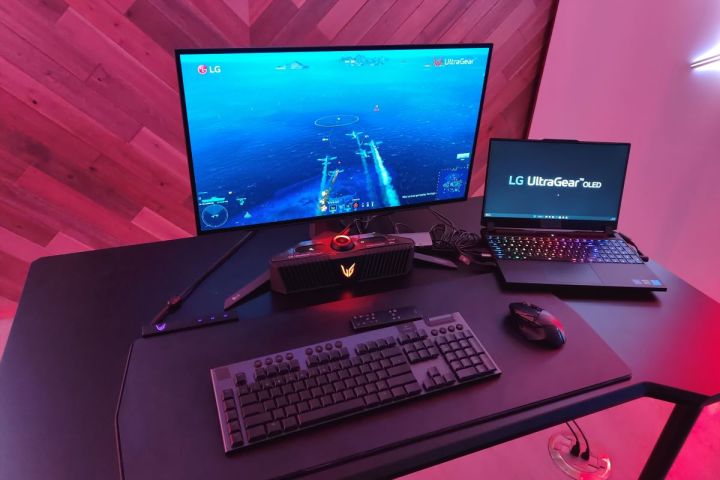 Fionna Agomuoh/Digital Trends
Fionna Agomuoh/Digital TrendsIn recent years several brands have brought more OLED displays from the TV market to the gaming monitor market while simultaneously inundating TVs with many gaming features. Still, as a leader in the OLED display market, LG has hit a milestone by releasing its own high-quality OLED gaming monitors. The brand is already collaborating with other companies to use its 27-inch OLED panel on new products.
The crowdfunded brand Dough (formerly known as Eve) recently announced its own Spectrum ES07E2D gaming monitor, featuring a 27-inch 240Hz OLED panel manufactured by LG. Meanwhile, Asus has teased plans to announce its 27-inch ROG OLED gaming monitor at CES 2023. Suffice it to say — LG is far from the only player in the game.
In comparison to the 45-inch UltraGear OLED curved WQHD gaming monitor, which was also showcased, the 27-inch UltraGear OLED might not have the razzle-dazzle of the 800R curved display. But when it comes to a familiar size that the average gamer will be comfortable with, it’s the more attractive offering.
Specs
| Screen size | 27-inches |
| Panel type | OLED |
| Resolution | 2560 x 1440 (QHD) |
| Peak brightness | 800 nits |
| HDR | Yes (HDR 10) |
| Response time | 0.03ms |
| Refresh rate | 240Hz |
| Curve | No |
| Speakers | None |
| Inputs | HDMI x 2, DisplayPort x 1, Headphone Out 4-pole (Sound+Mic), SPDIF out |
| USB ports | USB 3.0 Up-stream x1, USB 3.0 Down-stream x2 |
| Adjustments | Tilt -5 ~ 15 degrees, Swivel -10 ~ 10 degrees, Height Range 110 millimeters, Pivot counterclockwise |
| Wireless | N/A |
| Dimensions (WxHxD) | 23.8 x 13.8 x 1.8-inches (without stand |
| List price | $1,000+ |
Design
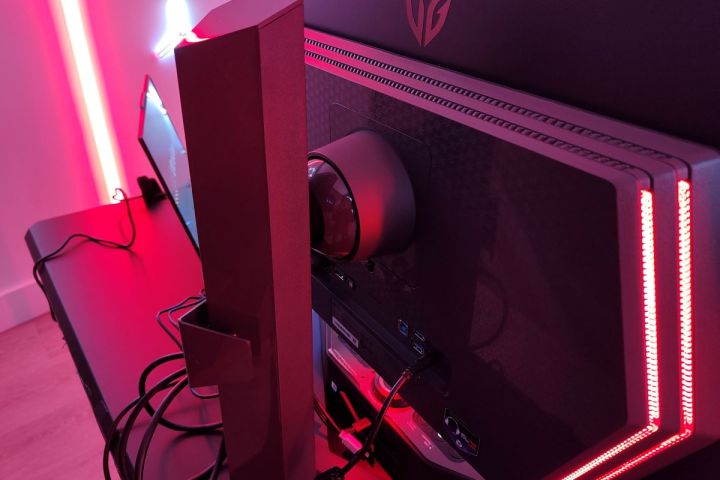 Fionna Agomuoh/Digital Trends
Fionna Agomuoh/Digital TrendsThere’s only so much that can be done in terms of design by a company that isn’t gaming-specific. It’s clear that LG put a lot more effort into the display quality of the UltraGear OLED QHD; however, if you had to describe the design, it would be sleek and simple. The 27-inch display is mounted on an adjustable and detachable base that is also 100 x 100 millimeters VESA compatible, so you can mount it on a wall.
However, it has tilt, height, swivel, and pivot adjustments and a height range of 110 millimeters. The adjustment mechanism is circular, which makes for easy moving; however, it is manual. The monitor comes in a simple dark color option, but it does include an RGB hexagon lighting pattern in the rear for a little bit of gaming flare.
An interesting feature of the 27-inch UltraGear OLED QHD is that it comes with a stand-alone dedicated remote, which directs you to a game dashboard. This accessory allows you to see which features are turned on or off during gameplay, and you can also adjust settings as you desire.
 Fionna Agomuoh/Digital Trends
Fionna Agomuoh/Digital TrendsSpecs such as frame rate and refresh rate are readily displayed, and you can see the variable refresh rate change in real time as well. There are a number of different built-in features such as various care for the OLED display, a gaming mode, gaming adjust, input settings, and other general features.
Ports
The UltraGear OLED QHD features a solid input setup including two HDMI ports, one DisplayPort 1.4 port, one headphone out 4-pole sound and mic port, one USB 3.0 up-stream port, two USB 3.0 down-stream ports and a SPDIF out port. Most ports are located in the rear below the adjustment mechanism, while the headphone jack is located on the underside right of the monitor.
While the monitor does not include built-in speakers, LG showcased its own UltraGear gaming speakers during the demo, which include a number of settings, such as USB, Bluetooth, fps, RTS, EQ, 3D gaming sound, and DTS. The UltraGear OLED QHD supports DTS HP:X audio for headphones and microphones, as well as SPDIF out for speaker connections.
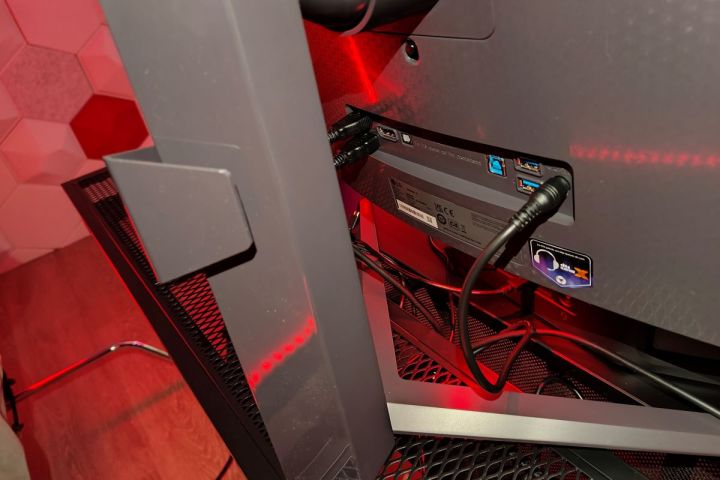 Fionna Agomuoh/Digital Trends
Fionna Agomuoh/Digital TrendsThis setup likely helped with the overall thin and near-borderless design of the LG UltraGear OLED QHD, but also makes audio accessories a necessity for this peripheral.
In comparison, the Dough Spectrum ES07E2D features a dedicated audio amp, despite having an overall slender frame.
Display quality
 Fionna Agomuoh/Digital Trends
Fionna Agomuoh/Digital TrendsOne thing I can say is that the images truly don’t do the LG UltraGear OLED QHD justice in terms of the quality of the display. The monitor uses the same OLED panels already seen on LG OLED TVs, and we’ve all seen how good gaming is on those screens. LG noted that the inclusion of DisplayPort 1.4 is one of the primary differences between its OLED gaming TVs and its new OLED gaming monitors.
Overall, I found the blues of the water shown on the displays to truly demonstrate the color depth and accuracy. Demos showed many seabound game scenarios, which have many similar color tones. Still, the distinct contrast between the blues of the water, and the greys and metals of the ships and fighter planes was apparent.
The racing game demos showed the brightness and color range. Reds were sharp and racing car blacks were distinct. Even the details on neighboring cars were not lost while focusing on what would be the main player.
Additionally, in comparison to the laptop connected to the monitor, which gave off a glare, and the LG UltraGear OLED QHD, which remained in a deep black, when transitioning to the all-black screen with the LG UltraGear branding, further demonstrated the color accuracy of the display.
Even if gaming is the primary use case for a high refresh rate, it also allows for more productivity-focused tasks, such as fluid web scrolling. LG said the LG UltraGear OLED QHD response time is much faster that its LG OLED TVs and 100 times faster than the average LCD TV. This feature also aids in drastically reducing input lag and motion blur compared to LCD monitors.
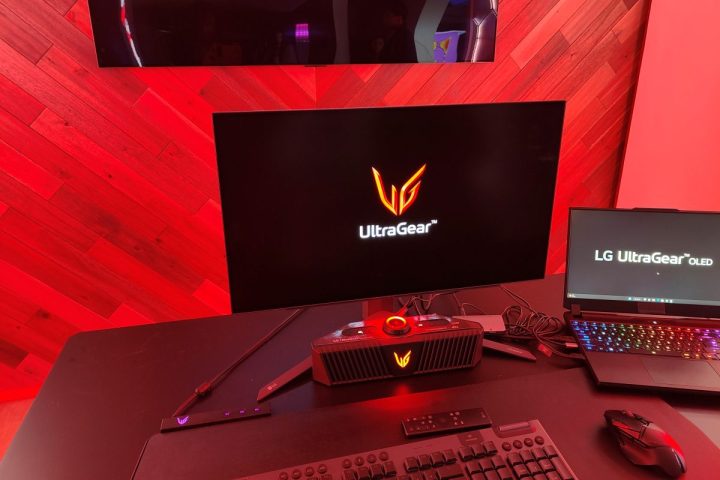 Fionna Agomuoh/Digital Trends
Fionna Agomuoh/Digital TrendsThe exact specifications for the display include a 26.5-inch flat 2560x 1440 resolution OLED panel with a 240Hz refresh rate, a 16:9 aspect ratio, and a 0.03ms GtG response time. It also has a color gamut of DCI-P3 98.5%, a contrast ratio of 1,500,000:1, a color depth of 1.07 billion colors, a pixel density of 110.8 pixels per inch (PPI), in addition to a typical brightness of 200 nits and a peak brightness of 800 nits at HDR 10.
HDR is obviously a huge benefit of moving to OLED and is a great example of something conventional IPS just can’t replicate. With a peak brightness of 800 nits and the fantastic contrast of OLED, you’re bound to get some decent HDR performance out of this thing, even if it doesn’t get quite as bright as the Alienware 34 QD-OLED. Gaming in HDR is something most PC gamers still haven’t experienced, and it makes a huge difference to the visual quality of games that support it.
Viewing angles on the UltraGear OLED, meanwhile, range from 178 degrees left to right and 178 degrees up and down. The display is also coated with anti-glare and low-reflection treatments to reduce the blue light bar allowing for reduced eye strain and discomfort and longer gaming.
The 200 nits of typical brightness seems a bit low, however, especially if you happen to have your PC set up near a window. We’ll have to wait to test it ourselves to get a feel for it, though.
Gaming
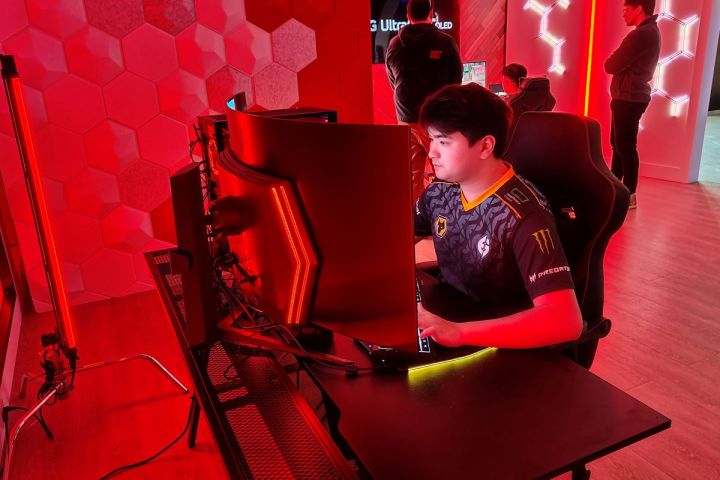
While I didn’t get to test out hands-on gameplay myself on the UltraGear OLED QHD, LG did have members of their partner esports team Evil Geniuses on hand to show off their gaming skills and to share their experiences playing on displays. They demonstrated playing Valorant on the 27-inch and 45-inch curved models respectively, giving their opinions of the gaming performance.
I found it most interesting that the gamers were easily able to detect each other within the gameplay while being fully immersed in the game and not having to move their heads around too much. The Evil Geniuses members relayed a similar sentiment, explaining the displays solve common issues where high refresh rates or frame rates on a display might equal diminished resolution and vice versa. They found the new LG UltraGear OLED models helped them stay more focused on their gameplay without having to worry about imperfections on the displays.
LG also noted that the latest high-end graphics cards such as the Nvidia RTX 4090 are expected to pair well with the UltraGear OLED QHD, supporting features such as its high resolution and fast frame rates simultaneously. This will allow gamers to maintain picture quality and gaming performance at the same time.
Who is the 27 UltraGear OLED QHD for?

It is clear that the LG 27-inch UltraGear OLED QHD is for gamers or even game enthusiasts. Its HDR performance and numerous gaming features make it fairly stacked as one of the go-to options for 2023. Even still, its $1,000 price is a great value proposition for those who intend to multitask and use the peripheral for not only gaming but for professional work or schoolwork as well.
I would have liked to see some additional features included, such as built-in speakers and more USB ports, but many of these challenges can be addressed with accessories that PC gamers already own.
The LG UltraGear OLED gaming monitor series consists of 27-inch flat and 45-inch curved models, which are currently available for preorder ahead of CES 2023 in January exclusively at LG.com. The gaming monitors come with the offer of expedited two-day shipping, and a free gaming pad, valued at $200.

 Konoly
Konoly 











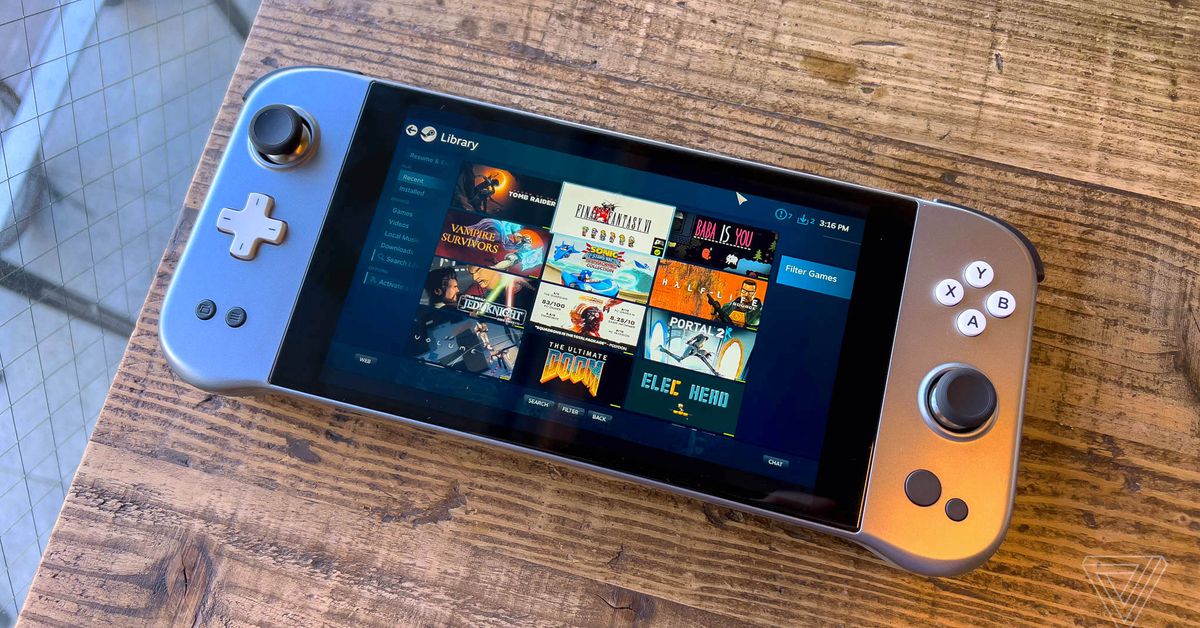

















![How CMOs Can Tell Stories To Manage Change [Case Study With Mondelēz International] via @sejournal, @gregjarboe](https://www.searchenginejournal.com/wp-content/uploads/2025/04/storytelling-634.png)


